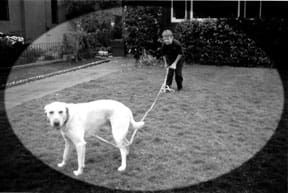For many dog-owner teams, the transition from leash-training to long-distance work can be a frustrating challenge. Some dogs frequently disregard our cues when they cross an indiscernible (to us) threshold. But he knows what come means! Z client wails, and points as proof to the fact the Ranger comes impeccably, every time, when called in the training center, the house, or the back yard.
The fact is that Ranger does know what come means in the training center, in the house, and in the back yard. He also knows that when he’s hiking in the woods with his human guardian, chasing squirrels and rabbits is far more entertaining and rewarding than coming back when he is called, especially since Come! Often means the hike is over, the leash is going on the collar, and we’re returning to the car.
How do you manage to make the transition from come reliably when called within a safe, controlled area to come reliably when called regardless of where we are or what other exciting things are happening?
Enter the long line: a behavior management tool that you can use very effectively to prevent Ranger from being rewarded by dashing off. The fact that he cant leave also gives you the opportunity to convince him that coming to you is irresistibly rewarding regardless of the circumstances.
Long lines come in many forms, from retractable leashes to light nylon lines, nylon check cords, or cotton training leashes, and range in length.
The purpose of the long line is simply to restrain Ranger so he cant get his adrenaline fix by tearing after Bambi in the woods it’s then up to you to make yourself interesting and exciting enough to get him to return to you. The long line is not for yanking or pulling a dog back to you that will only serve to confirm his opinion that playing in the woods is more fun than hanging out with you!
The following are some tips on the right way to use a long line as a training tool.
• Train a solid come response in controlled circumstances (for more information, see Total Recall, WDJ December 2000). Practice both with a long line in controlled circumstances as well as doing off-leash recalls, so the long line doesn’t always predict an adrenaline-generating adventure to the wilds of the woods.
• Use enclosed areas of different sizes to practice with Ranger on and off of the long line. If you practice only in your own back yard, and your own back yard is 30 x 50, Ranger is learning to come only from a maximum distance of 50 feet. Find a friend with a securely fenced pasture of an acre or more or go to a fenced community dog park during low-usage times when Ranger won’t be distracted by other dogs. You have to be able to do this off-line work without worrying that your dog will disappear into the National Forest for days at a time.
Note: If you plan to drop your long line and let the dog run with it attached to his collar, be sure you are not training anywhere where he might run off into the woods and get inextricably tangled around trees and brush.
• Whenever you arrive at a new location, do 5-10 minutes of recall practice (coming when called) on the long line, interspersed with other good manners training practice, before removing your dog’s leash. Then do a few minutes of focused off-leash training. This will teach him that training happens even in exciting places that a trip to his favorite park does not mean total lack of control, and that removing the leash is not an invitation to charge off into the brush.
• When you first let Ranger off the leash, do some short recalls and make them very rewarding use his absolute favorite treat that he gets only when he comes when called, or a quick game of fetch with a toy or ball that he obsesses over.
• As you hike around the large enclosed area with Ranger, look for opportunities to call him when he very likely to come that is, when he is looking a bit bored, not when he is fixated on a squirrel up a tree or totally preoccupied with digging a hole. When he comes, make wonderful things happen, then let him go play again. This teaches him that come means wonderful yummy fun-stuff break and then go play, rather than funs over, time to go home!
• Several times during the outing, put the long line back on Ranger’s collar, hold onto the end, and walk with him no more than 10 feet away from you on the line (this works in open pasture it does not work well in heavy woods and brush). When you (and he) spot a squirrel or a rabbit, call the dog to you. If he doesn’t come, don’t get angry and don’t drag him back to you with the long line, just wait until he realizes he can’t get to the squirrel, and is willing to return to you. When he does, tell him what a wonderful dog he is, have him sit, feed him a treat if he’s interested, then release the line, and say, “Go Chase.” Run toward the squirrel with him to encourage him, if he needs it.
This exercises teaches your dog the Premack Principle, which says that in order to get something really wonderful, he has to do something less wonderful first. In this case, the road to squirrel is through come to my person. As he gets better and better at responding, let him range farther and farther out on the long line until he will Premack back to you from 50 or more in order to earn his squirrel chase. (By the way, this also gives the squirrel a significant head start to the nearest tree and ensures that Ranger wont commit squirrelicide on his outings with you.)
Every once in a while, don’t release him to go chase you need to put the Go Chase on a variable schedule so he doesn’t think he gets to chase every time. Sometimes, like when it’s the neighbor’s cat, or the squirrel is across the street, a chase reward won’t be appropriate.
• When Ranger will return to you reliably from the distant reaches of the long line even in the face of thundering squirrels and rabbits, you are ready to try Premack off-leash. To increase your likelihood of success, do your first off-leash test when Ranger is near you. When the opportune moment arises say, when Ranger sees a squirrel at a distance call him to you, reward him with a treat if you like, have him sit, and then tell him to Go Chase! If he takes off after the squirrel anyway, don’t keep calling. Wait until he tires of the squirrel, then call him back to you in a pleasant tone, and go back to practicing on the long line. Do not punish him!
The temptation doesn’t have to be small speeding animals. It can be other dogs playing, an invitingly cool pond on a hot day, or an appetizing pile of horse manure. The reliable recall, trained with the help of a long line, can serve you well in an endless variety of challenging circumstances. You could be the dog owner who can proudly say, Ranger knows what come means everywhere, and every time!
-By Pat Miller






